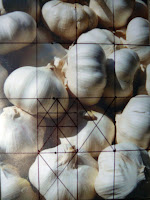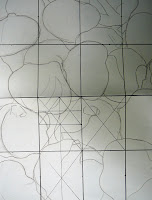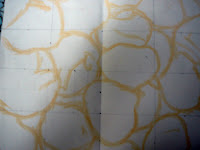Over the past few years, I have taught many beginning artists in various workshops. I have found that one of the most difficult and frightening aspects of starting a painting is the drawing. For most of us, being confident in the initial drawing is critical to how we will feel about our work at completion. So in teaching a workshop (whether it be watercolor or beginning in pastel), I just can't get around the first class: where to start with a drawing and how to design and craft a painting. Over the next few blog entries, I thought it would be helpful to post a few tips I follow that will help beginning artists be more successful in their paintings.

For students who have never drawn, creating a grid is one useful way to help you determine size, angle, and foreshortened relationships and perspective. If working from a reference, your first step will be to find the right proportion for your enlarged sketch (grid). I do this by laying the reference to the lower left corner of piece of sketch paper (large enough to fit your working surface). Draw a diagonal from the lower left corner to the top right corner. Any place on this diagonal that you draw 2 perpendicular lines, the rectangle will be proportional to your reference. This is the area you will use as your format for the larger painting and the area that will correspond to your grid.

Admittedly, there are many ways to make a grid. I will typically divide the paper and reference in half, 1/4 point and 3/4 point both vertically and
horizontally. The one rule... the grid should be the same in both your reference and your enlarged paper. You can further divide you grid as many times as necessary. My goal here is to simply create an
accurate line drawing to work from while painting. I will often revise my drawing as I go to fit what works for the painting. Most of the drawing is done with value and form in pastel. However, if my initial proportions are off, then I will never be able to accomplish what I want with value and form. Tip: I will place my reference in a sheet protector and create the grid on the plastic with a sharpie. This way, I can take the photo out later and see it without the distraction from the grid.

Once I have a drawing I am confident in, I will turn the paper over, cover the lines with graphite (for a watercolor) or hard pastel. Then I will lay the sketch paper over my painting surface (pastel side down) and retrace my initial sketch. Only the pastel sketch will be left on the surface and I am ready to start, almost...
 For this "breath of fresh - garlic", I have chosen a neutralized complimentary color scheme of "oranges" and "blues". Considering color harmony, I will keep my palette simple, choosing only a few colors within my color scheme that represent a variety in value (lights, darks, and midtones), softness, temperature (warm and cool colors) and chroma (intensity).
For this "breath of fresh - garlic", I have chosen a neutralized complimentary color scheme of "oranges" and "blues". Considering color harmony, I will keep my palette simple, choosing only a few colors within my color scheme that represent a variety in value (lights, darks, and midtones), softness, temperature (warm and cool colors) and chroma (intensity). .jpg) Form and value in painting are built by layering pastel of various hues and color temperature. Most often, I will work spatially, working an area as it occurs in space on the 2D plane. I begin with the most distant space and work towards the most forward space. That said, I continuously go back and make minor adjustments to previously worked areas to balance the colors and values throughout the painting. In general within these spaces, I work from dark to light and harder to softer pastel.
Form and value in painting are built by layering pastel of various hues and color temperature. Most often, I will work spatially, working an area as it occurs in space on the 2D plane. I begin with the most distant space and work towards the most forward space. That said, I continuously go back and make minor adjustments to previously worked areas to balance the colors and values throughout the painting. In general within these spaces, I work from dark to light and harder to softer pastel..jpg) Studying the light as it falls on the subject, I first lay in the darker and "cooler" color followed by the warmer darks. I consider this the foundation darks, followed by the lighter, softer color "on top". By accurately portraying these values, form and depth are created (and thus the "special effects" of painting).
Studying the light as it falls on the subject, I first lay in the darker and "cooler" color followed by the warmer darks. I consider this the foundation darks, followed by the lighter, softer color "on top". By accurately portraying these values, form and depth are created (and thus the "special effects" of painting). 






